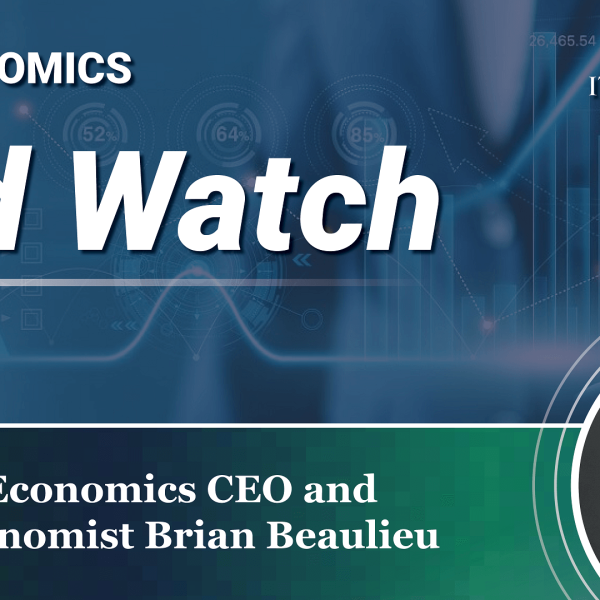- Mon - Fri: 8:30 - 5:00
- +1-603-796-2500
- ITR@itreconomics.com
with Brian Beaulieu
WEEKLY FED WATCH
Tune in to a new episode of Fed Watch with ITR Economics CEO Brian Beaulieu as he discusses the latest updates to important data series, federal government spending, and inflation expectations for the remainder of this decade.
Key Episode Takeaways
- 0:15 – New data released this week
- 1:06 – The core rate of inflation remained unchanged from February
- 1:15 – US Consumer Price Index went up
- 2: 10 – We are watching labor trends closely
- 3:34 – We need to see wage inflation come down on the service side
- 4:32 – We are not going to get much interest rate decline
- 4:54 – ITR Economics President Alan Beaulieu’s new blog on federal spending
- 6:00 – Summary, actionable advice, and conclusion
The below transcript is a literal translation of the podcast audio that has been machine generated by Rev.
Hello, I’m Brian Beaulieu. Thank you for joining me for this edition of Fed Watch. Today is Friday, April 12th, 2024. We have some big data releases come out this week. One was the consumer price index and quite frankly, that wasn’t great headline inflation. The overall inflation rate, that 1/12 rate of change went up to 3.5% if it’s going in the wrong direction in the March data, and it’s the highest that we’ve seen since May of 2023. And the month-to-month change in the index was at the upper range of normal, so it’s appreciably stronger than your average change, and that’s enough to make folks a little nervous about the Fed lowering interest rates in the third quarter or sometime in the second half of this year. The better news in terms of the CPI could be found in that the core rate of inflation, which is 3.8%, stayed flat. It was unchanged from February.
So while the overall CPI went up, core did not, and that’s a silver lining in some of that bad news. But striving, the CPI continues to be what we talked about last month. It’s the rental equivalency for owning your own home. Transportation services. Again, were up. Insurance in particular was up 22.2% was up 19% last year, so that continues to go up ferociously. Electricity is up 5%. Hospital costs are up 7.7%. Veterinarian costs are up 9.6%. So a lot of these things not so discretionary and therefore eating away at some disposable income in terms of toys and other type of fun things that you might want to buy this summer.
So it’s something we’re watching very carefully and all of its related to labor. If you look at the commodities part of the consumer price index, that was down 0.7% year over year. So it’s all in the labor still. And then the labor market remains relatively tight and we’re not going to see a big break in the labor. Even with the PPI report, which is the second big report that came out this past week, it was labor that was keeping that thing elevated. In fact, the March 1/12 for the producer price index, really… I don’t usually use words like this, but it was shot up to 1.9%. It had been minus 0.1% two months ago, and now it’s up to 1.9% and that was a steeper than normal increase one month to the next, and you have to go back to September of 23 to find a higher PPI, and that’s when it was coming down at that time. It’s going in the wrong direction right now. And it wasn’t in the finished goods, final demand was down 0.8%.
So commodities were down in unprocessed goods for intermediate demand, which tells you what the future is going to look like for finished goods. That was down 7.1%. It was all in the labor part of it. There’s final demand for services was up 2.8% and services are 67% of the producer price index. So it’s the service side of things and we need to see wage inflation come down. There’s still a shot at seeing that. We’ve seen it gradually come down, but not in our very broad-based manner. We’re still looking at signs of weakness. Inventories are high in certain areas. We talked about last week how the savings rate was down; the dollar savings were down. So we continue to think we’re going to get some interest rate relief beginning in the third quarter, and the futures market is saying the same thing by the way that we’re likely going to get that interest rate going down. I think it’s about a 70 to 80% probability is what the futures market’s building in for a rate decline beginning in the third quarter.
Clearly, we’re not going to get a whole lot of interest rate decline. We’ve talked about that before. And I mentioned total government issuances… treasury, not total government, but US treasury issuances, gross issuances, and how they have shot up above the level that they established at the federal government level during COVID. They’re on this issuing bonds and notes trend like you would not believe. It is incredible. And Alan wrote an interesting blog. It’ll be coming out I think next week. He did some looking at the federal government cash account, for instance, and the government’s cash account is a negative $1.6 trillion.
So they’re going to be issuing a lot of bonds and notes to come up with some cash ’cause they don’t have the cash. That negative amount is 40% larger than it was a year ago and is twice the average in the 10 years leading up into COVID. So this is a government that is starved for cash, has big spending plans, and a lot more debt is going to be floated out there. The spending is going to be continuing. It’s already baked into the pie, which means we’re even more certain than ever. That next round of inflation is the momentum behind that is already being put into place.
Fortunately, the money supply hasn’t rolled over yet in terms of a new rising trend, but it is certainly inching in that direction. And when you have all this fiscal stimulus and you have money supply rising, you’re going to get that inflation the next round of inflation. So grab the interest rates for whatever the low looks like at the end of 2024 or early 2025 because no matter what they are, they’re going to look good compared to what you’re going to find by the end of ’25, ’26, ’27, ’28, ’29, et cetera. So it’s a short window of opportunity. Make sure you grab it. Thanks for watching this edition of Fed Watch. See you next week.


